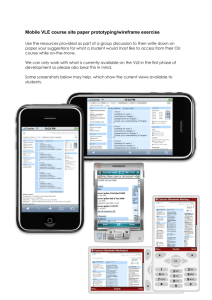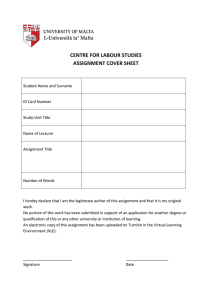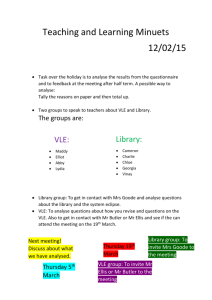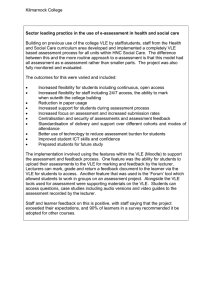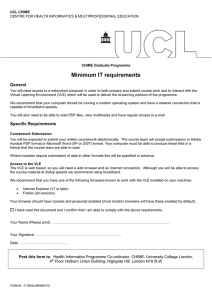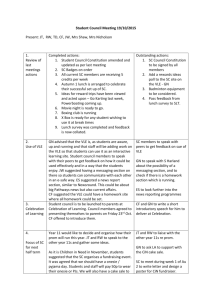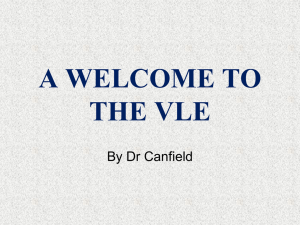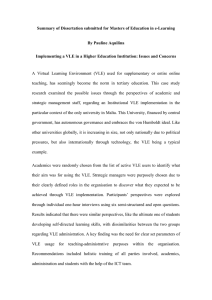CHAPTER 1 RESEARCH OVERVIEW 1.1
advertisement
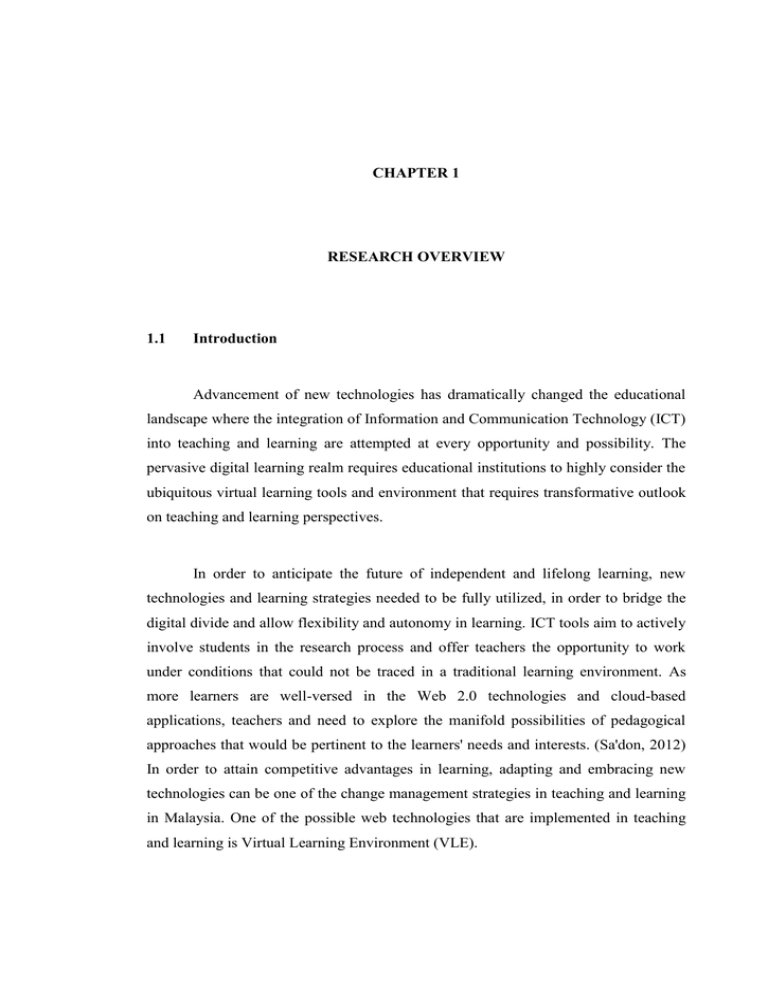
1 CHAPTER 1 RESEARCH OVERVIEW 1.1 Introduction Advancement of new technologies has dramatically changed the educational landscape where the integration of Information and Communication Technology (ICT) into teaching and learning are attempted at every opportunity and possibility. The pervasive digital learning realm requires educational institutions to highly consider the ubiquitous virtual learning tools and environment that requires transformative outlook on teaching and learning perspectives. In order to anticipate the future of independent and lifelong learning, new technologies and learning strategies needed to be fully utilized, in order to bridge the digital divide and allow flexibility and autonomy in learning. ICT tools aim to actively involve students in the research process and offer teachers the opportunity to work under conditions that could not be traced in a traditional learning environment. As more learners are well-versed in the Web 2.0 technologies and cloud-based applications, teachers and need to explore the manifold possibilities of pedagogical approaches that would be pertinent to the learners' needs and interests. (Sa'don, 2012) In order to attain competitive advantages in learning, adapting and embracing new technologies can be one of the change management strategies in teaching and learning in Malaysia. One of the possible web technologies that are implemented in teaching and learning is Virtual Learning Environment (VLE). 2 With the implementation of VLE in educational institution worldwide, knowledge acquisition and online learning management can be streamlined with ease. It aims to actively involve students in the research process and offer teachers the opportunity to work under conditions that could not be traced in a traditional learning environment. (Psycharis, S., Chalatzoglidis, G., and Kalogiannakis, M., 2013). VLE is a potent technology mediated learning literature augmented by prevalence of advanced technologies and virtualized resources. In the context of Malaysian schools, VLE is the nationwide initiative by the Ministry of Education Malaysia where its vision is parallel with the Malaysian Education Blueprint which states that VLE will be essential in grooming the students to meet the challenges of 21st century education globally. Hence, this research comprehensively studies the literature, existing framework and stakeholders‟ views pertaining to VLE implementation and management in international and Malaysian educational institutions. Three research papers have been published during the conduct of this research. First, the study on the role of knowledge management in VLE implementation is studied to identify the issues and concerns in the inception of VLE in Malaysian schools (Sa‟don, 2013). This is followed by a publication on an analysis of literature review pertaining the design of VLE framework for Malaysian schools (Sa‟don, 2013) and last but not least, a paper on the development of an integrated VLE Management Framework for Malaysian schools (Sa‟don, 2014) is written to further elaborate on its role and significance towards VLE Management in Malaysian Schools. 1.2 Background of the problem Technological advancements have exponential growth in paving changes in management of educational information and intellectual capital accruing from ubiquitous use of digital learning technologies. (Banyard, P., Underwood, J., Kerlin, L., & Stiller, J., 2011) The inception of Virtual Learning Environment (VLE) by the 3 Ministry of Education‟s vision on VLE in Malaysian schools nationwide is a great initiative as it possesses the “transformative potential to motivate engaging learning beyond the classroom boundaries” (Ministry of Education, 2014) In this context, every school will be equipped with high-speed 4G mobile Internet and a Virtual Learning Environment (VLE) will be made available in all schools nationwide. Nonetheless, managing such an ambitious and mega-scale educational project nationwide requires immaculate planning and proper management from the top management down to the grass-root level. There are several problems that need to be studied pertaining to the management of VLE in Malaysian schools. First and foremost, VLE is relatively in its infancy stage where its inception in Malaysian schools began in the year 2012 via 1BestariNet. Despite it is now implemented in all schools nationwide, there are still pending issues that need to be rectified promptly and accordingly. Among the problems identified are: (i) Nonexistence of an integrated framework on VLE Management in Malaysian schools Based from literature review conducted, most of the existing theoretical frameworks and empirical studies are on a particular aspect of VLE but very little research were focusing on integrating all of the elements in managing VLE effectively. In the context of Malaysian schools, it is imperative that reinforcement on the foundation of VLE management is established before the success of the implementation can be seen nationwide. Based on interviews conducted with the Educational Technology officers at the Educational Technology Division, Ministry of Education Malaysia, it is discovered that there is yet a standardized management framework used in all schools. Based on feedback given by the IT Managers in the survey conducted by the researcher on VLE Management in Malaysian schools, it is discovered that the schools manage the VLE based on various versions of VLE management plans conducted by the state educational technological divisions and it is not standardized nationwide. Despite training given on how to implement VLE in schools, the management mainly relies on the school decision. Hence, developing an integrated framework that is used nationwide for VLE Management would be an apt move. 4 (ii) Lack of academic research done on VLE in Malaysian schools The next problem identified is the lack of literature pertaining to VLE management in the Malaysian primary and secondary education context. Based on empirical studies, all of the researches done on VLE in Malaysia are focusing on the use of VLE in higher education (Hussein et. al, 2008; Ghavifekr and Husin, 2011, Mohammed Embi et. al., 2012). When the researcher conducted the preliminary study on VLE in Malaysian schools in 2012, there was no academic research published on VLE implementation in Malaysian schools. Most of the information gathered on VLE was mainly retrieved from 1BestariNet's website, an initiative by Ministry of Education for VLE implementation nationwide, FrogAsia, the national service provider of Frog VLE and features in mainstream newspapers such New Straits Times “TEACHING AIDS: Virtual Learning Platform Lauded (New Straits Times, 2013), yet none from academic research. To date, the current published research done on topic derived from this research initiated. The first is on the derivation of design of VLE framework for Malaysian schools (Sa‟don, 2013a) and the second focuses on Knowledge Management Enhancement in VLE implementation in Malaysian Schools (Sa‟don, 2013b). Hence, the lack of research done on VLE Management in Malaysia would impede managerial effectiveness due to inexistence of a standardized framework as a yardstick in managing VLE in all 10,000 nationwide. 1.3 Problem Statement In meting out the issues in implementing VLE in Malaysian schools, it is imperative to reinforce the foundation of VLE management and synthesize it with current education needs. Based on the aforementioned issues, the main problem in this research is “how can we develop VLE management in Malaysian schools?" This is followed by sub-questions to further narrow down the crux of the matter: 5 (i) What are the empirical studies and existing framework conducted on VLE management for educational institutions? (ii) What are the elements needed to enhance the current VLE management needs in Malaysian schools? (iii) How can the proposed framework on VLE management be validated for real-time implementation in Malaysian schools? 1.4 Project Objectives There are a few objectives that are determined in order to solve the issues in VLE Management in Malaysian schools. The objectives of this project are: 1. To study the existing frameworks on VLE management and identify strengths and gaps for refining the existing frameworks. 2. To identify the elements and factors of VLE that would offer management support in the implementation of VLE in schools in Malaysia. 3. To develop an integrated framework for VLE management that takes consideration of stakeholder‟s requirements. 4. To verify proposed framework design that depicts integrated vital requirements in VLE management in Malaysian schools. 1.5 Scope and limitation of the research The boundary of this study is in Malaysia where specifically, primary and secondary schools are the target parameters in studying the VLE Management. This scope is parallel with the Ministry of Education‟s vision on VLE in schools where it 6 has the “transformative potential to motivate engaging learning beyond the classroom boundaries” (Ministry of Education, 2014). Hence, the scope covers VLE Management in all categories of schools, both primary and secondary education. The main reason for restricting the VLE Management studies in Malaysian schools is because based from empirical studies, majority of researches done on VLE in Malaysia are primarily focusing on higher education or if set within the scope of schools, focusing on learning aspects only. 1.6 Significance of research There are several contributions of the research conducted. First and foremost, this research is important as there is yet any academic writing or research being carried out on VLE management in Malaysian schools as majority of the empirical researches either study on the pedagogical and technological aspects of VLE or focus on VLE in tertiary educational institutions such as colleges and universities. In the context of Malaysian primary and secondary education, there is no specific study done on Virtual Learning Experience (VLE) management in Malaysia. Research on VLE to date tend to emphasize more on features, component and technical aspects of the online learning management platform rather than provide guidelines for IT Managers, School Administrators or Instructors on the best way to optimize the management of VLE in their schools. Apart from that, most of the existing VLE framework either focus solely on technological aspects alone or simply limit the end-user interaction within the student and teacher perimeters. Apart from that, the chosen scope on VLE in Malaysian schools is timely as the outcome and findings of this government initiative will make Malaysia the first country in the world to make broadband access and a VLE available to all schools throughout the nation (Ministry of Education, 2012). 7 This research will help propel the rate of management success on Frog VLE in Malaysian schools nationwide. As it is only launched in March 2012 and tested by 30 schools as pilot project, there is a dire need to study and provide facilitation in managing the system for school administrators and IT Coordinators as the emphasis was more on the proper technicalities in handling the instructional technology rather than managerial skills and organizational efficiency. This was pointed out in a recent studies carried out by Educational Technology Division, Ministry of Education, Malaysia where connectivity issues and streamlining VLE training and supervision are some of the issues that were discovered during the pilot testing of Frog VLE (Soon, 2013) Hence, an integrated framework on VLE management that is standardized nationwide will ensure that every respective school follow standard of managerial procedures that can be realistically gauged, monitored and improved from time to time. It is high time we focus on ways to expedite intellectual capital amongst the school stakeholders in order to nurture knowledge workers that not only technological savvy but are able to optimize their knowledge in building the nation towards its full potentials. 1.7 Organization of Thesis This chapter focuses primarily in describing the problem background, where this research is based on the lack of studies done on VLE management in Malaysian schools. This leads to the derivation of research objectives that steer the focus of the research on providing better management support for VLE in Malaysian primary and secondary education. The scope of this research focuses on Frog VLE management where it is implemented in all schools nationwide. Eventually, from narrowing down the scope on Malaysian schools, significance of the research can be drawn upon the novelty of the research in the managerial parameters of educational settings for VLE implementation. Last but not least, the gist of each chapter is mapped out to show the flow of this research on VLE Management in Malaysian Schools.
